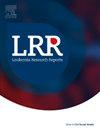Impact of non-coding RNAs on resistance to imatinib in chronic myelogenous leukemia
IF 0.9
Q4 HEMATOLOGY
引用次数: 0
Abstract
Imatinib is approved as the first-line treatment for newly diagnosed chronic myelogenous leukemia (CML). In spite of profound response in the majority of patients, resistance occurs in a subgroup of CML cases. Recently, it has been demonstrated that different classes of non-coding RNAs can modulate response to this tyrosine kinase inhibitor. Recognition of the role of these transcripts in this process not only expands our knowledge about the molecular mechanisms of imatinib resistance, but also provides novel strategies for combating this phenotype. The current review summarizes the role of non-coding RNAs in this process and suggests novel candidates for further studies in this field to enhance therapeutic response to imatinib.
非编码rna对慢性粒细胞白血病伊马替尼耐药的影响
伊马替尼被批准为新诊断的慢性粒细胞白血病(CML)的一线治疗药物。尽管在大多数患者中有深刻的反应,但耐药性发生在CML病例的一个亚组中。最近,已经证明不同种类的非编码rna可以调节对这种酪氨酸激酶抑制剂的反应。认识到这些转录本在这一过程中的作用不仅扩大了我们对伊马替尼耐药分子机制的认识,而且为对抗这种表型提供了新的策略。本文总结了非编码rna在这一过程中的作用,并提出了该领域进一步研究的新候选物,以提高对伊马替尼的治疗反应。
本文章由计算机程序翻译,如有差异,请以英文原文为准。
求助全文
约1分钟内获得全文
求助全文

 求助内容:
求助内容: 应助结果提醒方式:
应助结果提醒方式:


